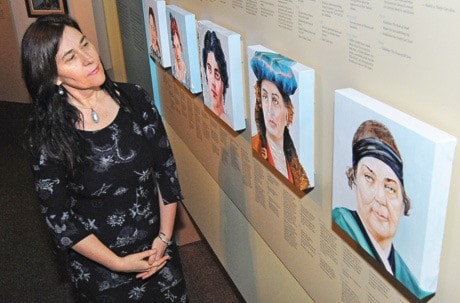When artist Manon Elder starting reading Emily Carr’s own writing, it didn’t jive with the story she’d read about her.
“When I saw how contemporary she felt, and how alive she felt, I felt that the image of her didn’t echo that,” she said.
“(Seeing) pictures of her in her youth – that was my ‘a-ha’ moment: ‘You need justice,’” Elder said of her impetus to paint B.C.’s most famous artist.
She launched a series of paintings based on photographs of the young Carr. After completing six, she called on Royal B.C. Museum curator Kathryn Bridge and pitched her show idea.
Bridge jumped at it.
“She’s bringing the photographs to life and she’s allowing me an excuse to go into the collections to do research,” Bridge said. While most tributes to Carr focus on her later life, this one seeks to understand the artist before she was famous – to dispel stereotypes of her as an eccentric, frumpy, cranky, isolated and unloved woman.
“She had idiosyncrasies, but they’ve been blown out of proportion,” Bridge said. “Yes, she had a lot of pets but they weren’t all pets. Part of it was a business – she raised purebred dogs.”
Carr was a normal kid, she added, except that she did love nature and was tomboyish. “She was never good with the starched crinolines ... she was a free spirit, but she wasn’t odd.”
The artist’s best-known biographies were written in the 1970s and focused mostly on Carr after the age of 20. Now, the Internet age has helped to uncover new information through digital records.
“People don’t realize that Emily Carr played the guitar and the mandolin and she did that in public settings,” Bridge said. “It’s all there in the newspapers, but in the years before you could do Internet searching, you had no idea.”
The exhibit, “The Other Emily,” aims to bring photos of Carr to life through Elder’s paintings, as well as many other mementos from that time, including her letters, manuscripts, period clothing and other objects.
And, of course, the exhibit includes Carr’s artwork, including 19 of her masterpieces and pen-and-ink sketches along with lesser-known works.
Elder brings her own perspective and modern elements to the 18 portraits of Carr on display.
For instance, her pub-fare receipt from the James Bay Inn, where Carr died, forms part of a collage in one portrait. In another, she paints a teenaged Carr with a gothic look.
In yet another, she transforms a black-and-white photo into a brightly coloured, four-panel painting in the style of Warhol.
“As a Canadian icon, Emily Carr is a star and Andy Warhol painted stars.”
The exhibit runs now through Oct. 10 at the RBCM.
rholmen@vicnews.com
